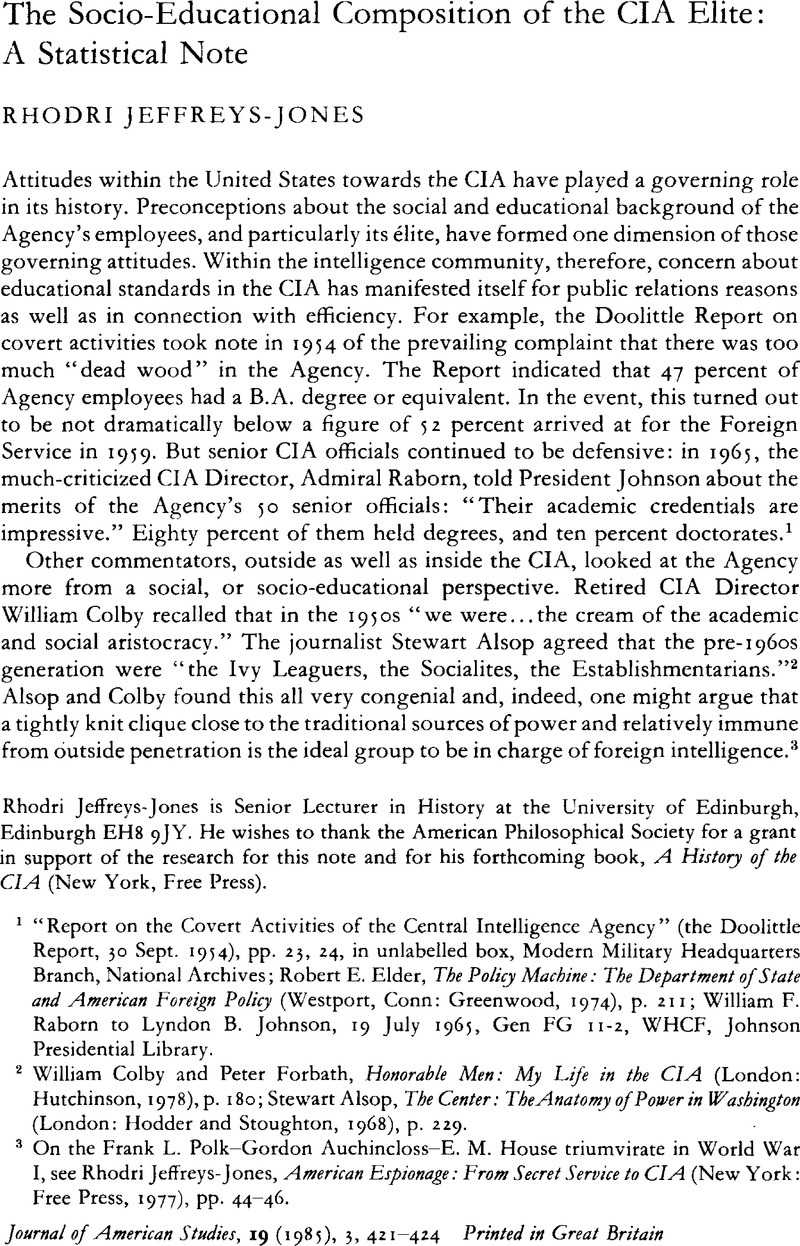Article contents
The Socio-Educational Composition of the CIA Elite: A Statistical Note
Published online by Cambridge University Press: 16 January 2009
Abstract

- Type
- Notes and Comment
- Information
- Copyright
- Copyright © Cambridge University Press 1985
References
1 “Report on the Covert Activities of the Central Intelligence Agency” (the Doolittle Report, 30 Sept. 1954), pp. 23, 24, in unlabelled box, Modern Military Headquarters Branch, National Archives; Elder, Robert E., The Policy Machine: The Department of State and American Foreign Policy (Westport, Conn: Greenwood, 1974), p. 211Google Scholar; William F. Raborn to Lyndon B. Johnson, 19 July 1965, Gen FG 11−2, WHCF, Johnson Presidential Library.
2 Colby, William and Forbath, Peter, Honorable Men: My Life in the CIA (London: Hutchinson, 1978), p. 180Google Scholar; Alsop, Stewart, The Center: The Anatomy of Power in Washington (London: Hodder and Stoughton, 1968), P. 229Google Scholar.
3 On the Frank L. Polk–Gordon Auchincloss–E. M. House triumvirate in World War I, see Jeffreys-Jones, Rhodri, American Espionage: From Secret Service to CIA (New York: Free Press, 1977), pp. 44–46Google Scholar.
4 Szulc, Tad, Compulsive Spy: The Strange Career of E. Howard Hunt (New York: Viking, 1974), p. 35Google Scholar; Yakovlev, Nikolai, CIA Target: The USSR (Moscow: Progress Publishers, 1982), p. 302Google Scholar; Kissinger, Henry, White House Years (Boston: Little, Brown, 1979), p. 306Google Scholar.
5 The author is obliged to David A. Williams, of Edinburgh University's Department of Statistics, for advice on method, and to Colin C. Nicolson, a postgraduate student, for his assistance in constructing the control group.
6 Codevilla, Angelo, “Reforms and Proposals for Reform,” in Roy, Godson, ed., Intelligence Requirements for the 1980's: Elements of Intelligence, rev. ed. (Washington, D.C.: National Strategy Information Center, 1983), p. 102Google Scholar; Lederer, William J. and Burdick, Eugene, “A Factual Epilogue,” in The Ugly American (London: Victor Gollancz, 1959), p. 273Google Scholar.
7 Propas, Frederic L., “Creating a Hard Line Toward Russia: The Training of State Department Soviet Experts, 1927–1937,” Diplomatic History, 8 (Spring 1984), 218CrossRefGoogle Scholar.
8 The information on Angleton's Rhodes scholarship was supplied by Professor Donald Cameron Watt of the London School of Economics in a conversation with the author on 8 February 1985. Bissell's spell at LSE is mentioned in the biographical entry on contributions to the Fall 1984 issue of Diplomatic History (Vol. 8, no. 4).
The computer missed the Bush entry because it contained the full title, “Central Intelligence Agency,” instead of the standard abbreviation “CIA.” The computer picked out some entries that were manually eliminated from the analysed list, such as the authors of books on CIA, and U.S. executives in Latin American corporations (Spanish abbreviation: “Cia”). The main problem is that some people may have omitted the CIA connection from their career synopses, either for personal reasons or in response to Agency requests which may have been issued from time to time for various unspecified reasons. In some cases, such as William Casey's, Marquis researchers made up the entries without the assistance of the listed persons, such entries being denoted by an asterisk.
- 3
- Cited by




